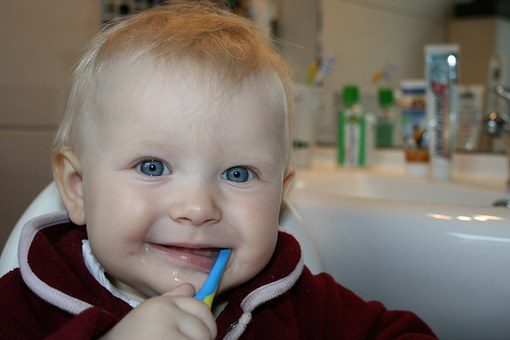Baby and Toddlers Dental Health Part 1

How to Brush Your Baby Or Toddler’s Teeth?
In this part 1 of 3 article series, we will look at tips for caring young child’s teeth.
Babies – Cleaning your babies teeth is extremely important. Even before your baby’s first tooth appears it is important to get your baby in the habit of having their gums cleaned. Using a damp gauze or cloth gently wipe your babies gums once a day. As soon as you see their first tooth emerging you must start to clean it at least once a day, again using a damp gauze or cloth and applying a tiny smear (around the size of a grain of rice) of age appropriate fluoride toothpaste and rubbing it around your babies’ teeth and gums.
Alternatively, you can use a small headed, soft bristled toothbrush. Increase to a pea sized amount of age appropriate fluoride toothpaste as more teeth appear.
Toddlers – Sit or stand behind your child in a well lighted area. In front of a mirror is ideal. This will allow your child to see what you’re doing. It’s often easier to sit a toddler on your lap. Use a hand to support their chin. Ask them to open their mouth. Look for any signs of decay, which may appear as white or brown lines on the teeth near to the gums or darkly stained grooves.
Check also for plaque build-up on the teeth near the gum line. Using a pea-sized amount of age appropriate fluoride toothpaste use a small circular motion to brush the surfaces of each tooth and the gums. Brush over the chewing surfaces. Take particular care with the back teeth. After you’ve finished brushing, ask your child to spit out any leftover toothpaste, but don’t rinse.
Avoid giving your child water to swish and spit because this might make swallowing toothpaste more likely. Rinse their toothbrush and allow it to dry. Store it somewhere clean. If your toddler’s teeth touch, you can begin flossing in between them.
Choosing the right toothpaste and toothbrush
For children aged 0–18 months use only water, no toothpaste.
From 18 months until your child turns six years old use a small pea-sized amount of low fluoride children’s toothpaste along with a soft children’s toothbrush.
From six years of age use a pea-sized amount of standard fluoride toothpaste along with a soft small children’s toothbrush.
Young children need help brushing
In early childhood it is you the parent that must take responsibility to assist in brushing and flossing your child’s teeth. You are accountable for preventing tooth decay, providing your child with a balanced diet and making sure all food, drink and medications taken are sugar free. This along with the correct brushing and flossing techniques will ensure your child stays free from dental disease. Continue to help and monitor your child until they are old enough to do it themselves. Usually at 8 years of age.
Making brushing time fun!
-
Make brushing a game: You can Invent your own game, with your own story lines. What is most important is that your child becomes interested, which will help them accept the clean.
Lead by example: Brush your teeth first to show that brushing is a normal thing, and that everyone brushes their teeth. This will also help you to be more diligent with your own oral care.
Look for fun products: Tooth brushes and tooth paste with their favourite character on it. Let them choose their oral care tools making sure it is a kid friendly soft bristle tooth brush and a low fluoride tooth paste.
Play a song during brushing: This will help to keep to time (3 mins of brushing is required twice a day). There are many tooth brushing songs available on line.
Create a brushing chart: Sign off your child’s success of brushing both morning and night, creating a non-food related reward system.
For part 2 of this article, click here now!
